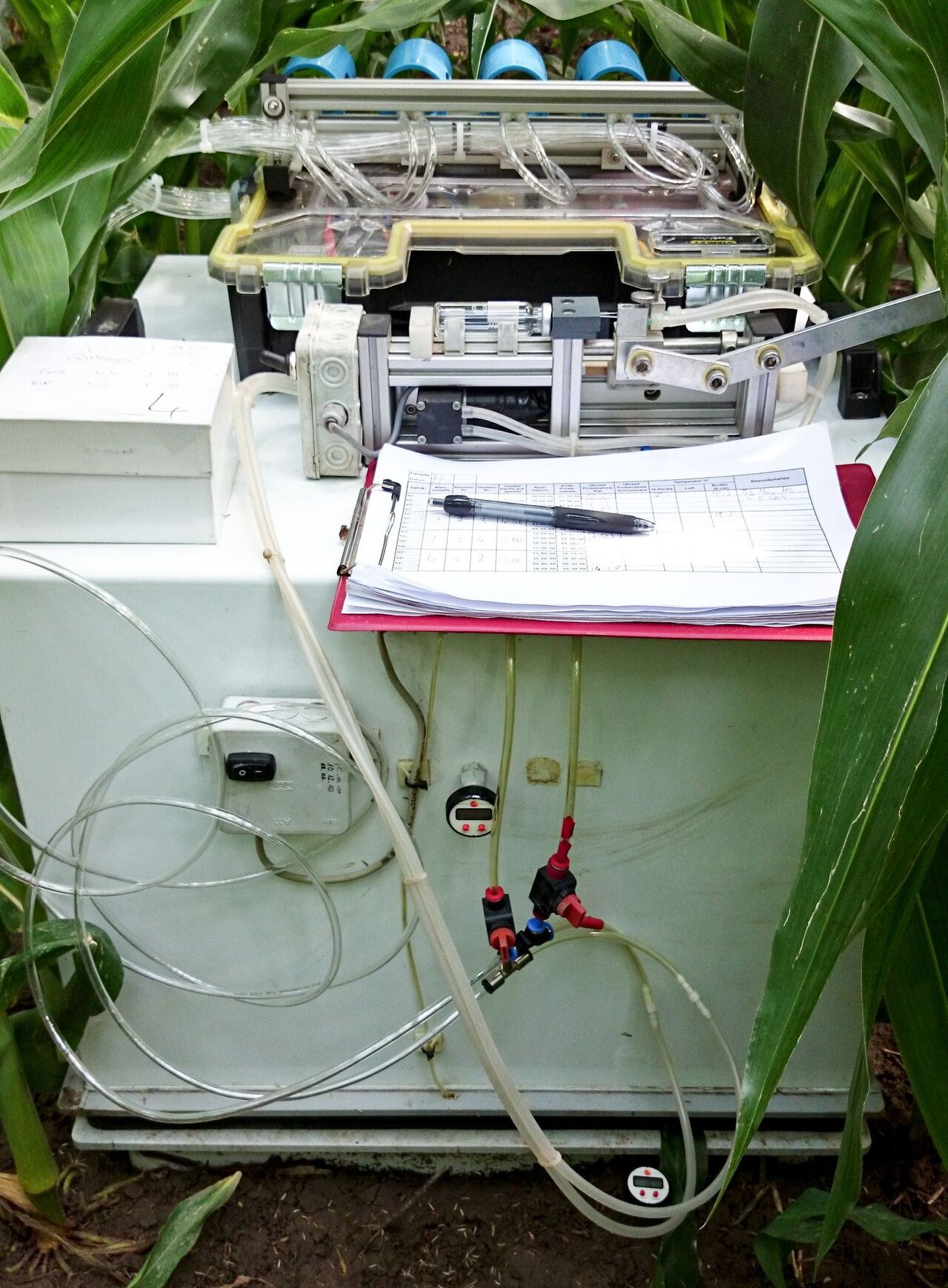Project
optimized climate farm

Climate-smart adaptation strategies for agriculture (optimized climate farm)
Regarding climate change, agriculture is both causer and aggrieved party. Heavy rainfall and extended dry periods make the calculation of plant available nutrients more difficult. Nitrogen, not used by plants, accelerates the climate change.
During the first project phase (2011 to 2013) in 3 model farms (cash crop farm, livestock holding farm with biogas plant, optimized climate farm with biogas plant) at the location Soest and Braunschweig under the project management of the South estphalia University of Applied Sciences it was investigated which climate change adaptation strategies would be especially effective in conventionally operating agricultural farms under practice conditions.
After systemic differences had been established, in the second project phase (2014 to 2016) the use of biogas digestate in reduced soil tillage will be optimized and the effects of the use of biogas digestate on greenhouse gas emissions are investigated.
Background and Objective
Within the framework of the second project phase in selected crop rotations field trials are created, to find the optimal nitrogen fertilization. The fertilization is carried out with biogas digestate, according to the resulting fertilizer quantities of the farm. The supplemental nitrogen fertilization is varied with additions and deductions from the target variant. From this the equivalent of the mineral fertilization can be derived. This is of special interest after beans. Legumes reduce the requirements of nitrogen fertilization. The legume nitrogen fixation can be a source of emissions of nitrous oxide. At the experimental site in Soest an additional strip till variant with a biogas digestate under feet fertilization in maize is investigated in optimized climate farm with biogas plant besides the fertilization with drag hoses. In this experimental plot as well as in the exact trials investigations are carried out concerning the emission of greenhouse gases and environmental incriminating gases (N2O, NH3). The Thünen Institute of Agricultural Technology is in charge of the assessment of tillage and management systems concerning the effects on soil structure and long term applicability of the soil tillage systems. One of the key aspects is the optimization of the practical procedure of straw management and the implements used for seeding and soil tillage in the three model farms.
Target Group
Science, policymakers, extension services, agricultural practitioners
Approach
Since 2010 at the locations Soest (750 mm/a precipitation) and Braunschweig (Northgerman lowland with 570 mm/a precipitation) three model farms had been established. The cash crop farm corresponds to a conventional farm without livestock. The fertilization is carried out only with mineral fertilizer. The cattle holding farm with biogas plant corresponds to a conventional farm with pig fattening and biogas plant. The climate optimized farm run as well a pig fattening and a biogas plant, but it uses a loosend up eight year crop rotation (beans – winter barley – silage maize – winter wheat – silage maize – rye – winter rape – winter wheat) and no till seeding when possible. The biogas digestates are used on the fields. Lacking nutrients are restocked by mineral fertilizers. The legume nitrogen fixation through beans reduces the amount of fertilizers.
Every year all 8 crops of the rotation are grown in large plots (0,5 ha), so that large sized agricultural techniques can be used. In the large cereal and rape plots small plots with an organic basic nitrogen supply with biogas digestate at the beginning of the vegetation period are generated. The mineral nitrogen fertilization is balanced at different fertilization levels. In cooperation with the Thünen Institute of Climate-Smart Agriculture emissions of nitrous oxide, methane- and carbon dioxide are weekly measured by means of closed measuring boxes. The Thünen Institute of Agricultural Technology at Braunschweig coordinates the experimental set up, carries out the yield determinations and assesses the soil physical parameters depending on the soil tillage system.
Data and Methods
To assess the emissions and nutrient removal, extensive additional research is carried out to investigate yield production, yield and quality of the crop harvested:
- Measuring yield effecting factors (soil cover by the crops, plant density, maximum plant height, pests and diseases, spike bearing stalks)
- Yields of cereals, beans and rape with a plot harvester
- Straw yield of cereals by hand harvesting of m² plots
- Yield of whole plant rye silage and green rye silage by hand harvesting of m² plots
- Yield of silage maize by hand harvest
- Recording the yield nitrogen content
For the control of the optimum nitrogen fertilization following investigations are carried out:
- Determination of N, P, K, Mg and S in biogas digestate at the time of spreading for balancing the nutrient input by biogas digestate
- Mineral Nmin content at the start and end of te vegetation period to balance the nutrient in the soil
For the control and evaluation of straw management and the used soil tillage techniques following investigations are necessary:
- Measuring the straw and plant residues after sowing with the line method
- Measuring soil physical properties at undisturbed soil samples (bulk density, pore volume, wilting point, available field capacity)
- Measuring the penetration resistance with a penetrologger
Our Research Questions
What effects do the farming systems cash crop farm, livestock holding farm with biogas plant and the optimized climate farm with biogas plant have on the soil structure and the longterm applicability of soil tillage systems with reduced soil tillage?
What influence have soil physical properties on the level of emissions?
What influence has the spreading of biogas digestate on plant growth, quality and demand-oriented fertilization?
Thünen-Contact

Involved external Thünen-Partners
-
Fachhochschule Südwestfalen
(Soest, Deutschland)
Duration
10.2013 - 3.2017





